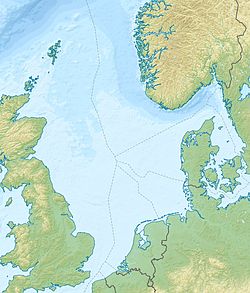Greater Gabbard offshore wind farm
| Greater Gabbard Wind Farm | |
|---|---|

Farm seen from a plane flying from Amsterdam to London
|
|
| Country | England |
| Location | Inner Gabbard and The Galloper banks North Sea Suffolk Coast |
| Coordinates | 51°52′48″N 1°56′24″E / 51.88000°N 1.94000°ECoordinates: 51°52′48″N 1°56′24″E / 51.88000°N 1.94000°E |
| Status | Operational |
| Commission date | 2012 |
| Owner(s) |
Scottish and Southern RWE Npower Renewables |
| Wind farm | |
| Distance from shore | 23 km (14 mi) |
| Power generation | |
| Units operational | 140 |
| Make and model | Siemens Wind Power: SWT3.6–107 |
| Nameplate capacity | 504 MW |
| Annual net output | 1,800 GW·h (2013) |
Greater Gabbard is a 504 MW wind farm on sandbanks 23 kilometres (14 mi) off the coast of Suffolk in England at a cost of £1.5 billion. Onshore construction activities commenced in early July 2008 at Sizewell. It was completed on 7 September 2012 with all of the Siemens SWT3.6–107 turbines connected.
A 336 MW extension of the project called Galloper Wind Farm was commissioned in April 2018.
The project was originally developed by Greater Gabbard Offshore Winds Limited (GGOWL) which was a joint venture between Airtricity and Fluor. Airtricity was subsequently bought by Scottish and Southern Energy who have bought out Fluor's 50% stake for £40m which is expected to cost £1.3b. Fluor are now contracted to design, supply, installation and commissioning of the balance of the plant. Scottish and Southern sold a 50% stake to RWE, the owners of Npower, in November 2008 for £308m.
The project was given the go-ahead in May 2008 and work started in June. In July 2011 erection of the turbines was two-thirds complete, with all the pile foundations installed.
In October 2009 Seajacks Ltd delivered its 7,000 tonne Leviathan vessel to Fluor Ltd which sailed to Harwich to prepare the hook-up and commissioning of an in-field substation and then installation of the turbines. The first foundations were installed in autumn 2009 with the first of a total of 140 turbines installed in the spring 2010. Electricity generation began on 29 December 2010 and construction was completed on 7 September 2012. During April 2014 to March 2015 the wind farm produced 1.7 TWh, corresponding to a capacity factor of 39%.
The wind farm can be seen from the Stena Line Harwich to Hook of Holland car & passenger ferry as it passes the turbines within a few kilometres.
An extension of the project, called Galloper, was agreed in May 2013. The proposal was to add up to 140 turbines to the development, producing up to 504 MW of electricity. The wind farm was expected to be completed in 2017. The project was being developed in partnership by RWE Innogy and SSE.
...
Wikipedia

